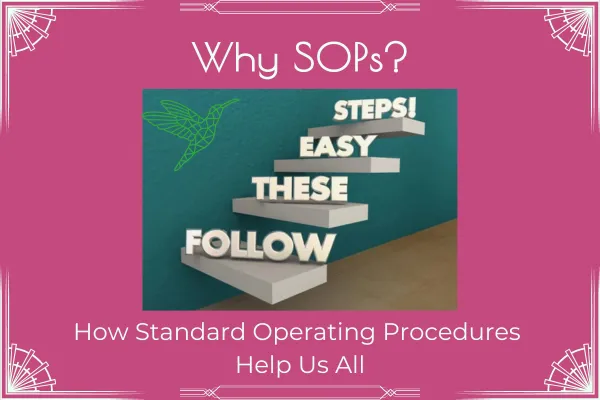
Why SOPs?
Why SOPS?: How Standard Operating Procedures Help Us All
In my over two decades of work experience, across large corporations, political offices, local governments, in education, and in the nonprofit sector, I have worked for ONE organization that had Standard Operating Procedures (SOPs) in place. (And my complaint with that one was that they never told me what it meant.) For more than half of my work experience, I ended up being the one to WRITE the SOPs… not because these were new organizations, or even new positions. But because it just does not seem to occur to most people to write down how to do the work.
Not having your SOPs (or as I was calling them back when I was writing them, the “how to’s”) written down is setting yourself and your organization up for failure.
Consistency, Quality Control, & Knowledge Transfer
SOPs help us ALL. Just from a purely business point of view, you want to have the steps of how to do each of the positions in your organization written down JUST IN CASE. I used to tell my colleagues that I wrote down how to do my job, and where to find it, in case I died in a fiery car accident. I was mostly joking, but I also like to be prepared! This took a lot of the stress off of trying to set everything up before I went on maternity leave (as well as the stress of potentially starting maternity leave early). It also helped a lot when I finally left that job, because I felt secure in the knowledge that the work that I cared about so deeply (because of the people that I served) COULD continue in my absence. The mission of that organization was very important to me, and as much as I was the one directing most of the work of that mission, I didn’t want everything to come to a grinding halt if I couldn’t come in anymore. So I set it up so that the work could carry on without me.
When leaders create SOPs, they can also make sure that the level of service and quality of work desired by the organization is encouraged, because this is a clear way to communicate it to people from the day they join the organization.
Training & Onboarding
Writing out these SOPs not only helped me with any anxieties I had about the work I had already done crumbling in my absence, but it also helped me any time I had to delegate a task, or train new people in the organization. I already had the steps written down. I would hand them the printed copy of the SOPs for them to follow along with as I physically showed them how to do the task (and when we started doing more remote work, I would record videos of myself doing the task on the computer, while explaining the how and the why, while sending the digital copy of the SOP). Having these different forms of instruction helped with training different types of learners, and they were a standard way to do things, so that we all knew where to find specific files (for example). And that’s what the one organization I worked for that already had SOPs in place used them for: TRAINING!
Productivity & Performance
The SOPs specific to each person’s position should be included in their onboarding to help them get started and know what is expected of them. In fact, having everything written down like this eliminates confusion among team members as to who is responsible for what. SOPs can avoid having things fall through the cracks because everyone knows who is responsible for what. They can also avoid having people double up on doing the same work, for the exact same reason.
Safety & Compliance
If your organization consists of more than one person, or even if it’s just you, but you deal with any living thing, or anything that could threaten living things, you need to have some kind of rules in place regarding how to maintain the safety of everyone who could be affected by the work being done. Often, guidelines (or straight up laws) are set by government organizations that need to be followed just to stay open. But I would also encourage leaders to develop rules for safety beyond the bare minimum required by law. Showing that you care about their safety is another way to build trust with your team(s).
Get the Creativity Flowing!
Having a common way of doing things throughout your organization does not have to limit creativity! It actually guides people in sticking to the mission, and can even help in just getting started. As a leader, you want to encourage your team to be innovative in their work, and sharing with them the mission and how the organization accomplishes this mission is actually a fantastic way to get people thinking about ways to improve and streamline what’s already there!
For ND individuals!
Besides all of the reasons already mentioned, having SOPs can be especially helpful for neurodivergent individuals.
For ADHDers: Having it written down can help us before we’ve had a chance to commit the job to long-term memory. And having template for the SOP we may need to write helps us to get started at times when having a blank page might result in overwhelm.
For Autistic individuals: Having the way you want things done standardized, written down, and clearly communicated can relieve anxiety and overwhelm whenever we’re asked to try something new.
For Dyslexic individuals: Be sure to have the SOPs available in a dyslexic-friendly font! And if you can have them done in some sort of graphic representation (i.e. a flow chart), even better!
For Learning Disabilities: As I mentioned above, it’s awesome to have that written down knowledge available to refer back to as needed, for as long as needed, but also to have watched it be done, so they can remember what was done as they review the written version.
Besides, setting up your workplace in a ND-friendly manner is great for everyone… Neurotypical individuals can learn just as much and just as well from the things that ND individuals learn better from. Again, no downside to setting up for everyone!
Conclusion
There’s literally no downside to having SOPs in place! The only hard part is finding the time to write them out and regularly update them, as needed. But it will benefit your organization far more in the long run to have them than to not.
With all this in mind, if you don’t already have SOPs in place, and don’t know where to start (or if yours are disorganized/outdated/or otherwise in disrepair), I have created something to help you out! Click below to purchase templates for both individual SOPs and a Master List to keep track of them. I’ve recorded a tutorial to walk everyone through the process of creating their own SOPs, and provided 2 sample SOPs related to the bundle as a whole. For only $10, you can be well on your way to having your organization better organized!



